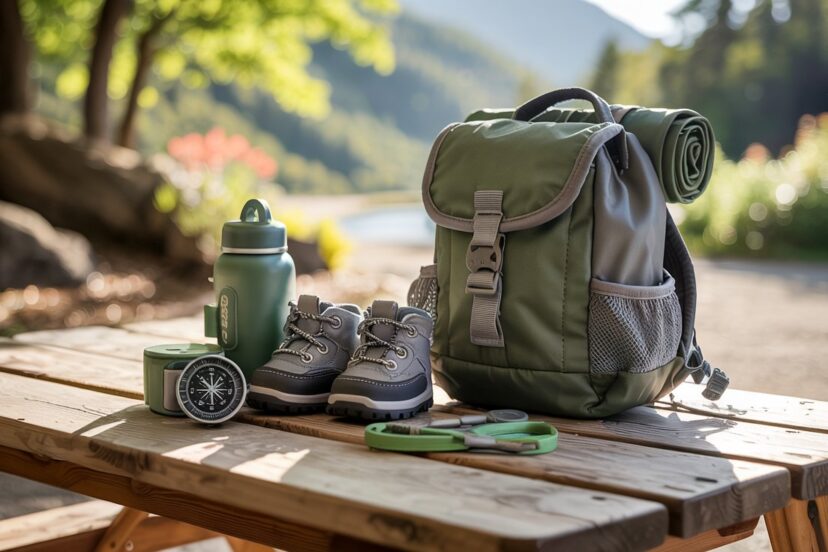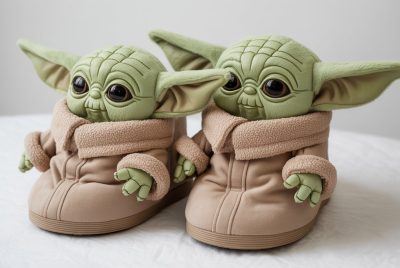Adventure-Ready Baby Hiking Gear Guide
*We may earn a commission for purchases made using our links. Please see our disclosure to learn more.
The moment I strapped my 6-month-old into a hiking carrier for the first time, I knew our outdoor adventures weren’t ending, they were evolving. That initial uncertainty quickly gave way to discovery as we found our rhythm on the trails. Three years and countless hikes later, I’ve tested dozens of products across varying terrains and seasons. What I’ve learned is that with the right baby hiking gear, hiking with babies and toddlers isn’t just manageable, it creates some of the most precious memories your family will cherish.
Key Takeaways
- Safety first: Always prioritize gear that protects your baby from the elements and ensures proper support for their developing body.
- Start with the essentials: A quality baby carrier designed for hiking is your most important investment.
- Layer appropriately: Babies can’t regulate their temperature as effectively as adults, so proper clothing is crucial.
- Pack strategically: Bring essential supplies without overloading yourself.
- Adjust expectations: Shorter trails and flexible plans make for more enjoyable experiences for everyone.
- Begin early: Introducing babies to nature from an early age helps foster a lifelong appreciation for the outdoors.
“Children who spend time in nature before age 11 are more likely to grow into adults who care about their environment than those who don’t have such experiences.”
— Richard Louv, author of “Last Child in the Woods: Saving Our Children from Nature-Deficit Disorder”
Top Recommended Baby Hiking Gear
1. Osprey Poco Child Carrier Backpack
The Osprey Poco Child Carrier Backpack is the ultimate choice for outdoor adventures with your little one. Designed with safety and comfort in mind, it features a fully framed and padded cockpit, adjustable Double Halo harness, and anatomical fit for your child. The AirSpeed backpanel ensures breathability for parents, while the adjustable torso length provides a perfect fit for various body types. With plenty of storage space and machine-washable components, this carrier makes hiking with your baby easier and more enjoyable.
- Comfortable Fit: Adjustable torso length and ventilated backpanel ensure comfort for both parent and child.
- Durable and Safe: Features a fully framed cockpit and safety harness for your child's security.
- Convenient Storage: Multiple compartments, including zippered pockets, provide easy access to essentials.
- Pricey: At $350, it may be on the higher end for some buyers.
- Bulky: The frame and extra padding can make it feel a bit heavy, especially for longer hikes.
- Limited Color Options: Available in just a few color choices like Black and Koseret Green.
As someone who’s tried multiple carriers, the Osprey Poco stands head and shoulders above the competition. This premium carrier provides exceptional comfort for both parent and baby, with a fully adjustable suspension system that distributes weight evenly. The integrated sunshade, ample storage compartments, and built-in kickstand make it perfect for everything from quick nature walks to serious day hikes.
What I particularly love is how the harness adjusts to different torso lengths, allowing my partner and I to easily swap carrying duties mid-hike without complex readjustments. The breathable back panel has prevented the sweaty-back syndrome I experienced with lesser carriers, even during summer hikes. My daughter always seemed most comfortable in the Poco, often falling asleep minutes into our trek despite bumpy terrain. While it’s one of the pricier options on the market (typically ranging from $290-$350 depending on the model), the durability, thoughtful design, and comfort justify every penny, my Poco has survived two children and countless adventures.
2. IVYGREEN Kids Hydration Backpack
The IVYGREEN Kids Hydration Backpack is perfect for young adventurers on the go. Designed for kids aged 3 to 12, this lightweight and compact backpack includes a 1.5L hydration bladder to keep your child hydrated during hiking or biking trips. Safety features like a chest strap with a whistle and reflective strips on both the front and shoulder straps enhance visibility, while the padded shoulder straps ensure a comfortable fit. With additional storage pockets for small outdoor gear, this backpack is ideal for any outdoor excursion.
- Hydration on the Go: Equipped with a 1.5L hydration bladder to keep kids hydrated during outdoor activities.
- Safety Features: Includes a chest strap whistle and reflective strips for added visibility.
- Comfortable Fit: Padded shoulder straps and back provide support for all-day wear.
- Small Capacity: The 5L storage may not be enough for longer excursions or bulky gear.
- Age Range Limitations: Best suited for children ages 3-12, limiting use as they grow older.
- Material Durability: Some users report that the material may not hold up well to rough handling.
Once your child is ready to take on the trails themselves, the IVYGREEN Kids Hydration Backpack is a fantastic choice for those first hiking or biking adventures. Designed for kids ages 3-12, it features a 1.5-liter hydration bladder that ensures they stay hydrated without needing frequent stops. The 5L capacity offers just enough room for snacks, a small jacket, and other essentials, while the reflective strips and safety whistle provide added peace of mind during outdoor activities.
The bite valve on the hydration bladder is easy for little hands to use, and the adjustable straps offer a comfortable fit, even during energetic spurts of running. I love how lightweight and compact the design is, making it the perfect starter backpack for young explorers. Plus, the padded shoulder straps and back ensure all-day comfort, whether they’re hiking a short trail or biking around the neighborhood. At around $30, it’s an affordable way to help your child develop the confidence and independence to take on outdoor adventures.
3. Sunday Afternoons Kids’ Play Hat
Keep your little one protected from the sun with the Sunday Afternoons Kids' Play Hat. With a UPF 50+ rating, this hat blocks 98% of harmful UV rays, making it perfect for outdoor activities like hiking, beach days, or backyard play. The wide brim and neck flap offer extra protection, while the Smartstrap Breakaway chinstrap ensures safety and comfort. This hat is also lightweight, quick-drying, and water-repellent, making it ideal for all-day adventures. Plus, it’s packable and can be easily stored when not in use, making it the perfect travel companion.
- Sun Protection: UPF 50+ certified, blocks 98% of UV rays for ultimate sun protection.
- Comfortable and Breathable: Made from soft, breathable polyester with mesh panels for improved airflow.
- Travel-Friendly: Packable design that retains shape and fits easily in bags.
- Hand Wash Only: Requires hand washing, which can be inconvenient for some.
- Size Options Limited for Younger Kids: The smallest size is for 1-3-year-olds, which may not fit toddlers under 1 year.
- Chinstrap Can Be Tight: Some users find the chinstrap a bit snug, especially for younger children.
Protecting delicate baby skin from the sun is non-negotiable on the trail, and this hat has been a constant companion on our adventures. The Sunday Afternoons Play Hat offers UPF 50+ sun protection with a wide brim, neck cape, and adjustable sizing that grows with your child.
The quick-drying, lightweight fabric keeps little heads cool, while the breakaway chin strap provides safety. I’ve appreciated how it stays on much better than other baby sun hats I’ve tried, even in windy conditions at higher elevations. The floating, crushable brim has survived being stuffed in backpacks countless times without losing its shape. What truly sets this hat apart is the neck cape, something I initially thought unnecessary until witnessing how effectively it protects the sensitive neck area that sunscreen often misses. Priced around $25-30, it’s been one of our most-used pieces of outdoor gear, lasting through multiple seasons and two children.
4. Keen Newport H2 Water Sandals (Toddler/Little Kid)
The KEEN Kids' Newport H2 Closed Toe Water Sandal is the perfect footwear for your active child who loves water adventures. Featuring washable polyester webbing and quick-dry lining, these sandals are designed to handle wet conditions with ease. The multi-directional lugs on the rubber outsole provide superior traction on slippery surfaces, while the high-abrasion rubber toe cap adds durability and protection. With an easy-to-adjust hook and loop strap, your child can slip them on and off quickly, making them perfect for busy outdoor days.
- Water-Resistant Design: Quick-dry polyester webbing and fully enclosed design keep feet protected and dry.
- Superior Traction: Multi-directional lugs and a non-marking rubber outsole offer great grip on wet surfaces.
- Comfort and Durability: Compression-molded midsole and high-abrasion rubber toe cap ensure long-lasting comfort and protection.
- Sizing May Vary: Some customers report that sizing can run slightly large, so it's important to check the size chart carefully.
- Price Range: At $47.08-$60.00, the sandals are on the higher end of the price scale for kids’ footwear.
- Limited Color Options for Some Sizes: Not all sizes are available in every color option, limiting choice for some buyers.
For older babies who are walking, proper footwear becomes essential. These Keen sandals have been our go-to for three summers running. The closed-toe design protects little feet from trail hazards, while the quick-drying material works equally well for creek crossings and muddy trails.
The non-marking rubber outsole provides surprisingly good traction for developing hikers, and the machine-washable material has stood up to everything my kids have thrown at them. I particularly appreciate the wide toe box that accommodates growing feet without constriction, something that traditional hiking boots often fail to provide. The elastic lacing system with hook-and-loop closure makes them easy for toddlers to put on independently, fostering that sense of “I can do it myself” that’s so important at that age. They’re available in infant sizes as small as 4 and continue through bigger kid sizes, allowing for consistency as feet grow. At approximately $45-55 per pair, they’re an investment that pays dividends in comfort and protection on the trail.
The Essential Guide to Baby Hiking Gear
Choosing the Right Baby Carrier
The foundation of successful hiking with a baby is having the right baby hiking gear, starting with a proper carrier. When my daughter was a newborn, I relied on a soft structured carrier for shorter, gentler hikes. The close contact kept her content, and the ergonomic design supported her developing hips in the recommended “M” position. For babies under 6 months who lack head control, look for carriers with built-in head support.
Around 6 months, when my daughter could sit unassisted, we transitioned to a framed hiking carrier, the investment that truly revolutionized our outdoor adventures. Beyond providing a comfortable seat, these specialized carriers include critical features like:
- Adjustable suspension systems to transfer weight to your hips rather than shoulders
- Kickstand for stable loading/unloading
- Weather protection (sun shades and rain covers)
- Storage compartments for diapers, snacks, and essentials
- Padded cockpits with adjustable harnesses for growing babies
- Stirrups for older toddlers to reduce leg fatigue
When selecting baby hiking gear, consider your typical hiking terrain and duration. For occasional, shorter hikes on well-maintained trails, mid-range carriers like the Deuter Kid Comfort Active offer excellent value. For more serious hikers tackling longer routes or varied terrain, premium options like the Osprey Poco Plus or Thule Sapling Elite provide enhanced suspension systems and additional features that justify their higher price point.
Remember that properly fitting your carrier is crucial, most outdoor retailers offer fitting services to ensure optimal weight distribution and comfort for both carrier and passenger.
Weather Protection and Clothing
Babies can’t regulate their body temperature as efficiently as adults, making appropriate clothing essential for safe hiking. I follow the layer system religiously:
- Base Layer: Moisture-wicking fabrics keep baby’s skin dry. Avoid cotton, which retains moisture and can cause chilling. Wool or synthetic base layers work year-round, cooling in summer and warming in winter. Brands like Patagonia’s Capilene and Smartwool make excellent baby base layers that, while pricey, often last through multiple children.
- Mid Layer: Fleece is ideal for insulation in cooler weather. Look for options with full-length zippers for easy on/off trail changes.
- Outer Layer: A waterproof, windproof shell is essential protection against unexpected weather changes. For babies in carriers, I prefer ponchos or jackets large enough to fit over both baby and carrier during sudden rain showers.
- Extremities: Babies lose significant heat through their heads, so pack hats appropriate for the season, sun hats with neck protection for summer and warm beanies for winter. Keep tiny fingers and toes covered in cooler weather with mittens and socks that stay put.
Regardless of season, remember that babies in carriers don’t generate heat through movement like hiking adults do. Even on mild days, I pack an extra layer for my carrier-bound explorers, especially for shaded trails or higher elevations where temperatures can drop unexpectedly.
Sleeping and Comfort Items
Many babies nap exceptionally well in carriers, lulled by the rhythmic motion of hiking. To maximize comfort for these on-trail naps, consider the following baby hiking gear tips:
- Head Support: For babies who tend to slump when sleeping, inflatable neck pillows designed for travel can provide comfortable head support within the carrier.
- Comfort Objects: A familiar small toy or lovey can provide security in new environments. Attach it to the carrier with a pacifier clip to prevent trail losses.
- White Noise: For babies sensitive to environmental sounds, portable white noise machines or smartphone apps can mask disruptive noises on busier trails, helping maintain nap schedules even in the wilderness.
- Carrier Accessories: Invest in any comfort accessories specific to your carrier model, many premium carriers offer attachable sunshades, rain covers, or insect nets that create a protected micro-environment for your precious cargo.
With these thoughtful additions to your baby hiking gear, you can help your little one stay cozy and content, ensuring that both baby and parent enjoy their outdoor adventures.
Diapering and Hygiene on the Trail
Leave No Trace principles apply doubly when hiking with babies. My diapering kit for the trail includes:
- Changing Mat: A lightweight, waterproof mat provides a clean surface anywhere.
- Diaper Disposal System: Scented bags specifically for diaper disposal contain odors until you reach a proper trash receptacle. Always pack out dirty diapers, never bury them.
- Hand Sanitizer: Essential for clean hands before handling food or after diaper changes.
- Minimalist First Aid: Beyond your standard hiking first aid kit, add baby-specific items like infant acetaminophen/ibuprofen, diaper rash cream, and baby-safe insect repellent (for babies over 2 months).
- Multipurpose Cleanup: Biodegradable wet wipes serve countless purposes beyond diaper changes, cleaning sticky hands, cooling hot faces, or refreshing dusty skin.
For longer hikes, I calculate diapers needed plus two extras, then store them in waterproof dry bags to protect from rain or water crossings. The extra weight is worth the peace of mind.
Feeding on the Trail
Whether you’re breastfeeding, formula feeding, or your baby has started solids, feeding considerations are central to successful hikes:
- Breastfeeding: Nature’s perfect trail food requires no preparation, but nursing in a carrier takes practice. Before hitting challenging trails, practice at home or on easy paths. Some carriers allow nursing without removing the baby, while others require a quick pit stop.
- Formula Feeding: Pre-measure formula powder in individual containers and pack enough water for mixing. Insulated bottle holders keep prepared formula at safe temperatures for limited periods.
- Solids and Snacks: For older babies, pack nutrient-dense, non-perishable options that won’t create crumbly messes in the carrier, pouches of pureed fruits/vegetables, banana chips, cheese sticks, or small containers of dry cereal work well.
- Hydration: Even exclusively breastfed babies may need additional water in hot weather or at higher altitudes. Introduce a small water bottle or sippy cup before your hike so they’re familiar with it when offered on the trail.
Remember that hiking increases caloric needs for nursing parents, pack extra high-energy snacks to maintain milk supply during your adventure.
Safety Considerations
While proper gear enhances safety, additional precautions create a secure hiking environment for little ones:
- Sun Protection: Apply baby-safe sunscreen (for babies over 6 months) to exposed skin, reapplying according to directions. For younger infants, rely on physical barriers like hats, lightweight long sleeves, and carrier sunshades.
- Temperature Management: Check baby frequently for signs of overheating or chilling. The back of the neck provides a good temperature gauge, clammy skin may indicate overheating, while cold skin suggests adding a layer.
- Trail Selection: Start with shorter, less challenging trails with bailout options. Research facilities beforehand—knowing where you’ll find changing stations, shelter from sudden weather, or quick exits can transform a potential crisis into a minor inconvenience.
- Communication Plan: Many hiking areas lack cell service. Discuss emergency plans with hiking partners before setting out, and consider a satellite communication device for remote adventures.
- ID Information: Attach identification to your child’s clothing when hiking. A simple luggage tag with your contact information, attached to their shoe or jacket, provides peace of mind in the unlikely event of separation.
Growth and Adaptation
As your little trail companion grows, their baby hiking gear needs will evolve:
- 0-6 months: Front carriers, weather protection, and minimal specialized gear beyond normal baby supplies.
- 6-18 months: Transition to framed back carriers, add sun protection, begin teaching trail etiquette.
- 18-36 months: Combine carrier use with short walking sections, introduce toddler-sized backpacks for sense of ownership, focus on proper footwear as walking increases.
- 3+ years: Transition from primarily carrier-based to primarily self-propelled hiking, with carriers available for challenging sections or when little legs tire.
Investing in adaptable gear that grows with your child maximizes value, adjustable sun hats, expandable carriers, and footwear with room to grow prevent constant replacements as your little hiker develops.
Practical Tips From the Trail
After countless miles with my little ones, these practical insights have made our adventures smoother:
- Trail Selection: AllTrails and Hiking Project apps allow filtering for family-friendly and stroller-accessible trails, providing realistic expectations before setting out.
- Timing Strategy: Plan hikes around nap schedules when possible, starting just before naptime often results in a sleeping baby and peaceful hiking for parents. Early morning starts typically yield the best temperament from both babies and crowds.
- Expectation Management: Recalibrate your definition of a successful hike. Distance covered matters less than experience gained. Some days, you might only make it half a mile before needing to turn back, embrace these moments as part of the journey.
- Community Connection: Join local hiking groups specific to families with young children. These communities provide trail recommendations, gear swap opportunities, and the incomparable support of parents facing similar challenges.
Conclusion
Introducing your baby to hiking isn’t just about recreation, it’s about laying the foundation for a lifetime of environmental connection. The right baby hiking gear transforms what might seem like a logistical challenge into one of the most rewarding experiences of parenthood. From that first carrier ride to those magical moments when tiny boots hit the trail independently, each step nurtures your child’s relationship with nature.
Start small, invest wisely in quality gear that prioritizes safety and comfort, and remember that flexibility often determines the success of any outdoor adventure with little ones. The temporary weight of extra equipment is nothing compared to the lasting memories you’re creating with each trail you explore together.
Frequently Asked Questions
At what age can I start hiking with my baby?
With proper gear and precautions, many pediatricians support hiking with babies as young as 2-4 weeks old for gentle, short excursions. Start with smooth, flat trails and gradually progress as your comfort and baby’s development allow. Always check with your pediatrician first, especially for babies born prematurely or with health concerns.
How do I protect my baby from insects while hiking?
For babies younger than 2 months, rely on physical barriers like carrier insect nets or lightweight clothing that covers arms and legs. For older babies, the American Academy of Pediatrics approves insect repellents containing 10-30% DEET, applied sparingly to clothing and exposed skin (avoiding hands that might go into mouths). Natural repellents containing oil of lemon eucalyptus should not be used on children under 3 years.
How much water should I bring for my baby while hiking?
Exclusively breastfed babies under 6 months typically don’t need supplemental water, but in hot weather, you might offer small amounts (1-2 oz) after nursing. Formula-fed babies and those eating solids require additional water—a good guideline is 1.5x their normal consumption for hiking days. Always bring more than you think you’ll need, especially in warm weather or higher altitudes where dehydration risks increase.
What’s the weight limit for most child hiking carriers?
Most framed hiking carriers accommodate children from 16 pounds (when they can sit unassisted, typically around 6 months) up to 40-50 pounds (roughly age 4-5 years). However, parental comfort typically becomes the limiting factor before reaching these maximum weights. Most parents find the sweet spot for comfortable carrying ends around 35-40 pounds, though this varies based on carrier quality, parental fitness, and trail difficulty.
How do I handle diaper changes on remote trails?
Always pack out all diaper waste in sealed bags, following Leave No Trace principles. For remote trails, carry a small dedicated dry bag containing a changing pad, wipes, hand sanitizer, and several diapers. Select natural areas away from water sources and trails for changes. In particularly sensitive ecosystems or very popular trails, consider using a portable travel potty with disposal bags for older babies and toddlers who are beginning potty training.
















